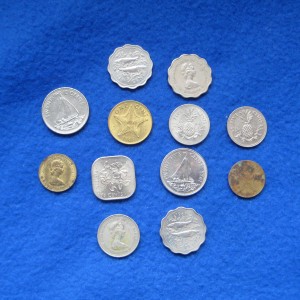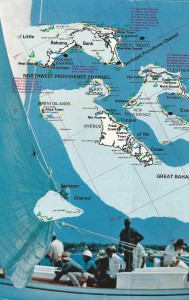Searching For Bottles Leads To Shipwreck “Treasure”
I had no idea I would learn so much about shipbuilding and “treasure coins” when Bob Allen and I discovered an old wooden sailing vessel sunk off Andros Island in the Bahamas. We were searching for bottles in the shallow waters of Fresh Creek Inlet, Andros Town, when we spotted a shipwreck listing slightly to its starboard side near a sandy embankment. The wreck was about 75 to 80 feet long and could have been one of the many inter-island cargo carriers that plied Bahamian waters years ago. The tall, once sturdy mainmast was broken in half, a sign that the vessel might have been caught in a storm after running aground on the shoal.
The cargo holds were empty and everything had been stripped from the pilothouse. But leave it to Allen, always the sleuth, to find something of value. Hovering over the base of the broken mast, he frantically beckoned to me. I swam over, but all I saw was a thick wooden frame that secured the mast to the deck. I had no idea why he kept pointing to the support. Using a piece of the wreck’s scrap metal as a crowbar, he started prying it up. When the mast sprung free of its underpinning, a dozen Bahamian coins—the lump sum of the ship’s treasure—rolled on to the deck. Most of them were in assorted shapes from the 1960s with pictures of fish, pineapples and sailboats on different denominations.
Bob has “unstepped” the mast! In shipbuilding, “stepping the mast” is a ceremony held at the end of a ship’s construction. One or more coins are placed onto the mast step (a socket, frame or platform for supporting the lower end of a mast) before the mast is secured. Sailors have long held the superstition that a coin placed beneath the mast brings good luck. This practice is believed to have originated with the Romans. It was their custom to place a coin in the mouth of a dead person to pay Charon, the boatman who ferried the souls of the dead across the river Styx to the afterlife. Sailors felt their debt was paid—if the ship sank and they died—with the coins placed beneath the mast.Mast stepping has outlasted the gods and goddesses of Roman mythology. A Spanish wreck discovered off the coast of England had a coin dated 1618 under the mast. When Old Ironsides, the USS Constitution went to a Boston shipyard for refurbishing, the masts were pulled and out popped several Colonial era coins. Officers of the heavy cruiser USS New Orleans, launched in 1933, put 33 coins under her fore and mainmasts. When the Navy destroyer USS Higgins was commissioned in 1999, there were 11 coins specially selected for her stepping, some dating back to Roman times.
One of the best stories comes from Ralph Winter of Lansing, Michigan. While attending the Suburban Detroit Coin Show, he inquired about hobo nickels. These were creative sculpted art forms carved into small-denomination coins during the early 1900s. Many were done by hobos who exchanged them for a meal or shelter. They used nickels which were softer and easier to carve.
Winter failed to find any hobo nickels, but he discovered an unusual Buffalo nickel at a dealer’s table. It was a beautiful AU (almost uncirculated) 1915 coin with an anchor etched into it and the numbers “51” stamped on both sides. His diligent research revealed the coin came from the navy destroyer USS O’Brien—DG 51 which was commissioned in 1915. It had been stepped (a term Winter had never heard of) during a pre-commissioning ceremony honoring the new ship and its traditional shipbuilding process.
Landlubbers might scoff at sailors for following this superstitious stepping ceremony. But in the end, you know what? Let’s just leave it up to the individual to play along or not. (Knock on wood!).
4 Comments
Submit a Comment
All Rights Reserved © | National Underwater and Marine Agency
All Rights Reserved © | National Underwater and Marine Agency
Web Design by Floyd Dog Design
Web Design by Floyd Dog Design




I had heard of “stepping the mast” but never knew what it really meant. This is very interesting. Thank you for writing about your experience. After being inspired by your article, I am going to look for a hobo nickel at the next coin show I attend. Wish me luck. Hope I find one, knock on wood! Thanks again.
The Andelana, a British 4 masted bark that sank in Tacoma’s Commencement Bay in 1897 had a Gold Sovereign under each mast and it has been the holy grail of Tacoma divers for 80+years.
What an interesting and entertaining article! I am somewhat embarrased to say that although I am a 10 year Navy Veteran I had never heard of Stepping the Mast and did not read or study that in our Naval History while in boot camp. I am extremely interested in Maritime and Naval History and intend to begin reading more now that I have the time. I just placed a bid on 2 signed copies of two of Clive Cussler’s books which were donated to a Homeless Veterans Transition Center which is how I ended up here on this website tonight and was fortunate enough to come across your article which I enjoyed VERY MUCH! Thank you again for sharing it.
Thank you for your kind words. There are many people, including yours truly, who did not know what “stepping the mast” means. Now, every time I see a ship with a mast, I wonder what’s beneath it!